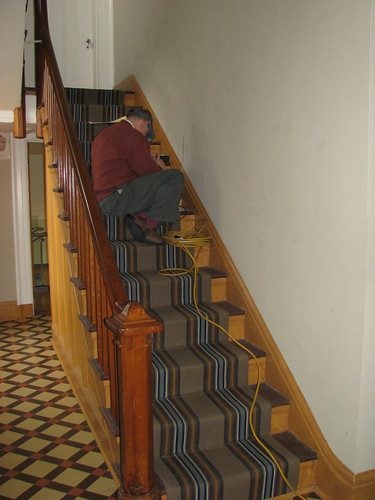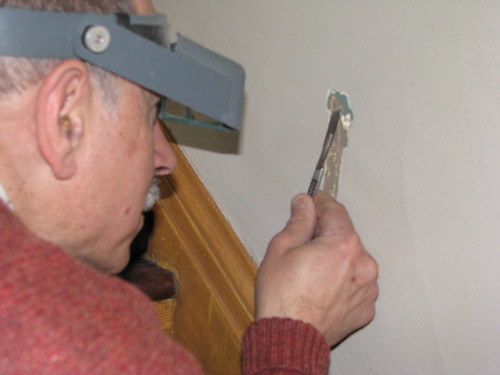By Jeffrey Larry
 President Lincoln’s Cottage is only one year from completion of an extensive seven year restoration, but the job of preserving this 167 year old building is ongoing. Not long after the restoration was completed small hairline cracks became visible on the wall going up the stairs from the first to second floor and second floor to attic. Eventually the cracks began to connect leading small sections of the finish coat of plaster began to separate from the base coat. The plaster on this wall was originally applied to an interior brick wall. The concern was that it had begun to separate from the brick due to moisture or structural issues. Fortunately, a small area of the finish coat removed on the second floor wall revealed the base coat of plaster was intact. The cause of the cracks still had to be determined before making a repair.
President Lincoln’s Cottage is only one year from completion of an extensive seven year restoration, but the job of preserving this 167 year old building is ongoing. Not long after the restoration was completed small hairline cracks became visible on the wall going up the stairs from the first to second floor and second floor to attic. Eventually the cracks began to connect leading small sections of the finish coat of plaster began to separate from the base coat. The plaster on this wall was originally applied to an interior brick wall. The concern was that it had begun to separate from the brick due to moisture or structural issues. Fortunately, a small area of the finish coat removed on the second floor wall revealed the base coat of plaster was intact. The cause of the cracks still had to be determined before making a repair.
For several decades in the 20th century, the Cottage had been used as administrative offices for the Soldiers’ Home and was climate controlled year round, which meant limited structural expansion and contraction on the interior. During the restoration, while existing cracks in the plaster were being repaired, the Cottage was not climate controlled, returning it to the gradual–but extreme–seasonal temperature fluctuations a 19th century house would experience, which may have caused enough movement in the structure to form these additional cracks. To address this problem all of the loose and cracked plaster finish coat will be removed and the base coat examined to ensure that it is sound.
Whenever original Cottage architectural material is removed or disturbed the process is photographed and documented. Typically the original material is then labeled and stored. Because so much of the original finish coat of the plaster would need to be removed, and the two previous paint analysis projects did not include this wall, it was deemed necessary to conduct a new paint analysis.
The examination of the paint layers and removal of samples for laboratory analysis took place on April 3, 2009 and marked the return of Matthew Mosca, an Historic Paint Finishes Consultant who had last examined the Cottage 27 years ago. In 1985, Mosca was commissioned as part of a National Park Service Historic Structures Report initiated by the Home to conduct paint analysis on many of the walls and trim of what was then known as Anderson Cottage, with an eye to turning it into a museum. The Home never proceeded with the preservation and development work.
In 2000, the National Trust for Historic Preservation, a private, non-profit organization, became the steward of the Cottage, finally realizing the preservation and interpretation of this important place. As part of the restoration, Frank Welsh of Welsh Color & Conservation, Inc was contracted to conduct a more in-depth paint analysis that eventually took nearly 400 samples from the exterior trim, walls and windows as well as interior walls, trim and doors. This paint analysis, along with Mosca’s 1985 survey, has proved to be an invaluable source of information regarding the finishes present during Lincoln’s occupancy of the Cottage. Unfortunately a lack of time and money prevented a more in-depth study of the finish layers, in particular, the evidence found of a painted decorative frieze in many of the rooms and the continued search for fragments of wallpaper.
The final results of Mosca’s latest analysis should be completed by the end of April 2009 and will be followed by the plaster repair. Check back to this site often for preservation updates on President Lincoln’s Cottage.


